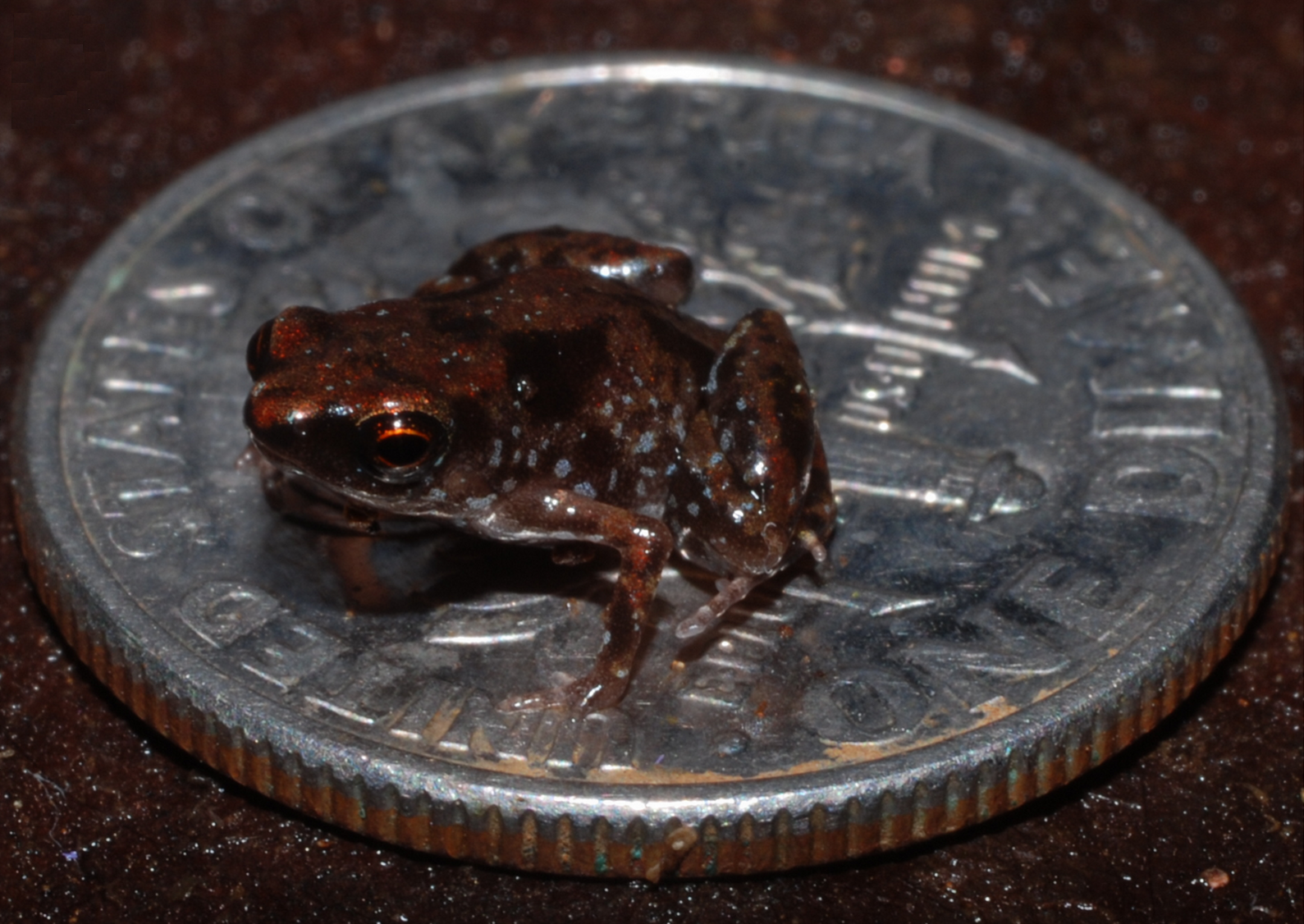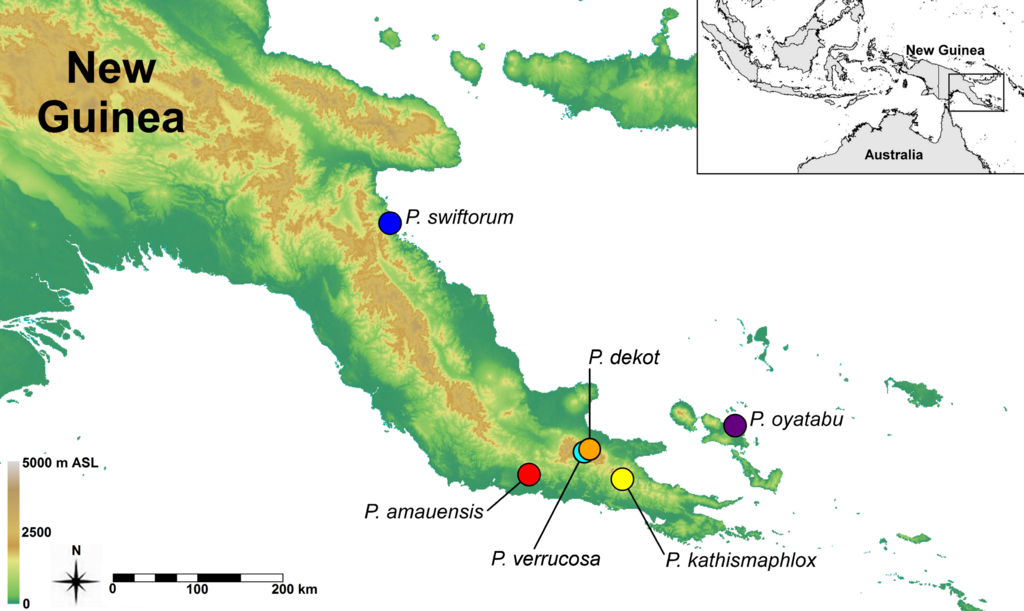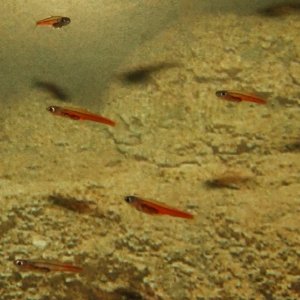Welcome to another post of my strange animals series where you get to meet some of the weirdest, coolest, and craziest animals on a daily basis!
Today I want to introduce you to Paedophryne amauensis, a tiny frog that holds a double record. This creature is not only the smallest frog known to man, but also the smallest vertebrate. How small you ask? Well, they say a picture is worth a thousand words...
 Paedophryne amauensis dwarfed by a mere U.S. dime (credit, CC BY 2.5)
Paedophryne amauensis dwarfed by a mere U.S. dime (credit, CC BY 2.5)
As you can see, the frog is about the size of a fly, measuring a bit over 7 millimeters! But this itty bitty frog doesn't only have the size of an insect. It also produces calls that resemble those made by insects. This is why it remained unnoticed for so long, being officially described only in 2012!
Now let's learn more about this little guy, starting with a quick history lesson!
The discovery
The species was discovered in August 2009 by Louisiana State University herpetologist Christopher Austin and his PhD student Eric Rittmeyer, during a three-month long expedition to the island of New Guinea. The frog was found near Amau village in the Central Province, from which the specific name (amauensis) is derived.
In 2012, the scientists published a paper [2] officially describing the new species. In the corresponding press release [1], they explained that these frogs are extremely hard to notice as they are very small and the calls they use resemble sounds made by insects. Furthermore, these frogs camouflage themselves in the leaves of the forest floor making them even harder to spot.
 A map of the localities of the six known Paedophryne species (credit, CC BY-SA 2.5)
A map of the localities of the six known Paedophryne species (credit, CC BY-SA 2.5)
"It was particularly difficult to locate Paedophryne amauensis due to its diminutive size and the males' high pitched insect-like mating call." said Christopher Austin back then.
The discovery was made while the researchers were searching for new species of thee Paedophyrne genus. All the frogs in this genus are extremely small and the high pitch of their calls makes them almost impossible to locate using the human ear alone. So they resorted to more advanced means!
They used sound triangulation and after some hit and miss their efforts paid off:
"So we triangulated to where these calls were coming from, and looked through the leaf litter. It was night, these things are incredibly small; so what we did after several frustrating attempts was to grab a whole handful of leaf litter and throw it inside a clear plastic bag. When we did so, we saw these incredibly tiny frogs hopping around." said Austin, to BBC News
Here's a video of Chris Austin talking about their discovery:
So this is pretty much the backstory of the discovery!
Why are they so damn small?
At 7.7 mm (0.3 inches) long on average, one definitely wonders why and how this frog got so small! Well, there is no definite answer yet but there are some theories going on.
The prevailing one is that they have adapted to fill a niche filled by no other animal, consuming tiny invertebrates, like mites, that are ignored by bigger predators.
"These creatures aren't just biological oddities, but instead represent a previously undocumented ecological guild -- they occupy a habitat niche that no other vertebrate does." explains Austin. [3]

(credit)
What else do we know about this tiny frog?
Not much really! Here's a quick breakdown of the basics:
- Lifecycle & Behavior: They begin their life as miniaturized adults, bypassing the tadpole stage. Once mature, they spend the rest of their life hidden in the forest flora, only coming out to forage. They seem to be crepuscular (active primarily during twilight) and males emit a high-frequency, insect-like call when they want to mate.
- Diet & Enemies: As aforementioned, they eat tiny invertebrates that larger predators ignore. Ironically, they probably fall prey to other, larger than themselves, invertebrates like scorpions
- Conservation Status: Like the rest of the species in the area, they are threatened by human-related activities that result in habitat loss, for example deforestation & climate change. Sad :(
That's pretty much all we know about this elusive species, although you can read some details on the paper published by Christopher Austin and Eric Rittmeyer. [3]
The End
Before I close my post, I want to give a honorable mention to Paedocypris progenetica, which used to hold the record for world's smallest vertebrate before the discovery of P.amauensis.
P. progenetica is a species of cyprinid fish endemic to Sumatra (Indonesia) where it is found in peat swamps and blackwater streams.

Paedocypris progenetica (credit, CC BY-SA 3.0)
Hope you enjoyed reading about the world's smallest vertebrate! See you in my next strange animals post :)
References
- Sciencedaily.com/releases/2012/01/120111223352.htm
- Journals.plos.org/plosone/article?id=10.1371/journal.pone.0029797
- Lsu.edu/departments/gold/2012/01/austin.shtml
- Nationalgeographic.com/news/2012/01/120111-smallest-frogs-vertebrates-new-species-science-animals/
- Bbc.com/news/science-environment-16491477
- Wikipedia.org/wiki/Paedocypris_progenetica

My dear readers, thank you for reading today's article. Hopefully, you found it interesting enough to follow me, @trumpman, if you want to discover more weird and bizarre creatures from all around the word! Here are the last 5 weirdos of this series:
- The King of Herrings: Horrifying, yet Harmless
- Slimy Jewels: 11+1 Nudibranchs That Will Blow Your Mind
- Cebrennus rechenbergi: The Spider That Wanted To Be A Gymnast
- Beauty Stings: The Stinging Rose Moth Caterpillar
- Pacific Barreleye: Meet the Fish With the Transparent Head!
Steemstem & Steemit Education
Interested in science? Please, don't forget to check the @steemstem project, a community-driven project meant to promote well-written, high-quality, STEM-related content (STEM as for Science, Technology, Engineering and Mathematics). Just click here to join us! And for those engaging with education, @steemiteducation is here to join all steemian educators in their common cause of making the job easier, more effective and more fun!
Greek Community
A big thanks goes to my fellow greeks who support me with their love! You guys rock! A special mention also goes to @rouketas and @skapaneas for bringing us all together! I love you guys all :)

